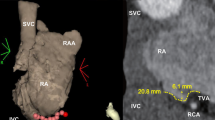Abstract
Background
The lesion size index (LSI) predicts radiofrequency (RF) ablation lesion size and is an established parameter for pulmonary vein isolation. However, the effectiveness and safety of LSI for cavotricuspid isthmus (CTI) linear ablation remain unclear.
Methods
This single-center retrospective study included 50 of patients (67 ± 10 years, 68% male) who underwent de novo CTI linear ablation between July 2020 and December 2020. The LSI target was set at 5.0 and 4.0 for the anterior 2/3 and posterior 1/3 segments, respectively. Acute procedural parameters of ablation were evaluated.
Results
Acute bidirectional CTI block was achieved in all patients with an RF application time of 4.0 min (3.1–5.0 min), RF application number of 15 ± 7, and length of CTI of 36.9 ± 9.3 mm. First-pass bidirectional conduction block of the CTI was achieved in 39/50 (78%) patients. No major complications were observed. The contact force (CF) per application was significantly lower in the gap tag group than in the non-gap tag group (7 g [7–8 g] vs. 10 g [7–12 g], P = 0.0284).
Conclusions
LSI-guided CTI linear ablation is an effective and safe treatment approach. CF affects gap formation, even when the target LSI is the same.




Similar content being viewed by others
References
Riva S, Tondo C, Carbucicchio C, Galimberti P, Fassini G, Bella PD, et al. Incidence and clinical significance of transformation of atrial fibrillation to atrial flutter in patients undergoing long-term antiarrhythmic drug treatment. Europace. 1999;1:242–7.
Pérez FJ, Schubert CM, Parvez B, Pathak V, Ellenbogen KA, Wood MA, et al. Long-term outcomes after catheter ablation of cavo-tricuspid isthmus dependent atrial flutter: a meta-analysis. Circ Arrhythmia Electrophysiol. 2009;2:393–401.
Natale A, Newby KH, Pisanó E, Leonelli F, Fanelli R, Potenza D, et al. Prospective randomized comparison of antiarrhythmic therapy versus first-line radiofrequency ablation in patients with atrial flutter. J Am Coll Cardiol. 2000;35:1898–904.
Calzolari V, de Mattia L, Indiani S, Crosato M, Furlanetto A, Licciardello C, et al. In vitro validation of the lesion size index to predict lesion width and depth after irrigated radiofrequency ablation in a porcine model. JACC Clin Electrophysiol. 2017;3:1126–35.
Kanamori N, Kato T, Sakagami S, Saeki T, Kato C, Kawai K, et al. Optimal lesion size index to prevent conduction gap during pulmonary vein isolation. J Cardiovasc Electrophysiol. 2018;29:1616–23.
Mattia L, Crosato M, Indian S, Causin E, Licciardello C, Antonio P, et al. Prospective evaluation of lesion index-guided pulmonary vein isolation technique in patients with paroxysmal atrial fibrillation: 1-year follow-up corresponding author. J Atr Fibrillation. 2018;10:1858.
Kanda Y. Investigation of the freely available easy-to-use software ‘EZR’ for medical statistics. Bone Marrow Transplant. 2013;48:452–8.
Cabrera JA, Sánchez-Quintana D, Farré J, Rubio JM, Siew YH, et al. The inferior right atrial isthmus: further architectural insights for current and coming ablation technologies. J Cardiovasc Electrophysiol. 2005;16:402–8.
Giehm-Reese M, Kronborg MB, Lukac P, Kristiansen SB, Jensen HK, Gerdes C, Kristensen J, Nielsen JM, Nielsen JC. Recurrent atrial arrhythmia in a randomised controlled trial comparing contact force-guided and contact force-blinded ablation for typical atrial flutter. J Interv Card Electrophysiol. 2022;63:699–707.
Sakama S, Yagishita A, Sakai T, Morise M, Ayabe K, Amino M, Ikari Y, Yoshioka K. Ablation index-guided cavotricuspid isthmus ablation with contiguous lesions using fluoroscopy integrated 3D mapping in atrial flutter. J Interv Card Electrophysiol. 2022;64:217–22.
Schillaci V, Strisciuglio T, Stabile G, Salito A, Arestia A, Agresta A, Shopova G, De Simone A, Solimene F. Cavotricuspid isthmus ablation by means of very high power, short-duration, temperature-controlled lesions. J Interv Card Electrophysiol. 2022. https://doi.org/10.1007/s10840-022-01197-x.
Zhang T, Wang Y, Han Z, Zhao H, Liang Z, Wang Y, et al. Cavotricuspid isthmus ablation using ablation index in typical right atrial flutter. J Cardiovasc Electrophysiol. 2019;30:2414–9.
Venier S, Andrade JG, Khairy P, Mondésert B, Dyrda K, Rivard L, et al. Contact-force-guided vs. contact-force-blinded catheter ablation of typical atrial flutter: a prospective study. Europace. 2017;19:1043–8.
Jones MA, Webster D, Wong KCK, Hayes C, Qureshi N, Rajappan K, et al. The benefit of tissue contact monitoring with an electrical coupling index during ablation of typical atrial flutter—a prospective randomised control trial. J Interv Card Electrophysiol. 2014;41:237–44.
Reddy VY, Dukkipati SR, Neuzil P, Natale A, Albenque JP, Kautzner J, et al. Randomized, controlled trial of the safety and effectiveness of a contact force-sensing irrigated catheter for ablation of paroxysmal atrial fibrillation: results of the TactiCath contact force ablation catheter study for atrial fibrillation (TOCCASTAR) Study. Circulation. 2015;132:907–15.
Kumar S, Morton JB, Lee G, Halloran K, Kistler PM, Kalman JM, et al. High incidence of low catheter-tissue contact force at the cavotricuspid isthmus during catheter ablation of atrial flutter: Implications for achieving isthmus block. J Cardiovasc Electrophysiol. 2015;26:826–31.
Lozano Granero C, Franco E, Matía Francés R, Hernández-Madrid A, Sánchez-Pérez I, Zamorano Gómez JL, Moreno J. Impact of power and contact force on index-guided radiofrequency lesions in an ex vivo porcine heart model. J Interv Card Electrophysiol. 2022;63:687–97.
Author information
Authors and Affiliations
Corresponding author
Ethics declarations
Ethics approval
This study conformed to the Declaration of Helsinki and was approved by the Ethics Board of the Committee of Kitasato University Hospital (No. B21-163).
Consent to participate
All patients provided informed consent.
Conflict of interest
The authors declare no competing interests.
Additional information
Publisher's note
Springer Nature remains neutral with regard to jurisdictional claims in published maps and institutional affiliations.
Rights and permissions
Springer Nature or its licensor holds exclusive rights to this article under a publishing agreement with the author(s) or other rightsholder(s); author self-archiving of the accepted manuscript version of this article is solely governed by the terms of such publishing agreement and applicable law.
About this article
Cite this article
Murayama, Y., Kishihara, J., Fukaya, H. et al. Lesion size index-guided cavotricuspid isthmus linear ablation. J Interv Card Electrophysiol 66, 485–492 (2023). https://doi.org/10.1007/s10840-022-01360-4
Received:
Accepted:
Published:
Issue Date:
DOI: https://doi.org/10.1007/s10840-022-01360-4




